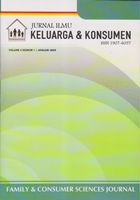STIMULASI PSIKOSOSIAL PADA ANAK KELOMPOK BERMAIN DAN PENGARUHNYA PADA PERKEMBANGAN MOTORIK, KOGNITIF, SOSIAL EMOSI, DAN MORAL/KARAKTER ANAK
Abstract
The study aimed to identify psycho social stimulation given at selected play groups in Bogor and its effect to motor, cognitive, socio-emotional, and moral development of children participated in the play groups. The play groups were classified into two groups which were play groups for children from upper middle class family’s (namely group KB1) and play groups for children from lower class family’s (namely group KB2). The study design was prospective cohort study, which observed child’s development of 89 children for 3 months. Psycho social stimulation at play group including facilities at play group, programs for development competencies, and variation of learning method. The facilities, programs and methods of KB1 was better than KB2, but only facilities was statistically significant. During 3 months there where an increase of scores in term of child’s motor, cognitive, socio-emotional, and moral development of children from the both group. Age of child, psycho social stimulation at home and facilities at play groups influenced significantly to motor development and cognitive development of children at both group. Factors influenced to child’s socio emotional development were psycho social stimulation at home and facilities provided at play groups, while moral development was possitively influenced by facilities and method at play groups. In contrast an increasing of program for child’s competency was likely to decrease moral development score of children
Authors submitting manuscripts should understand and agree that copyright of manuscripts published are held Jurnal Ilmu Keluarga dan Konsumen. The statement to release the copyright to Jurnal Ilmu Keluarga dan Konsumen is stated in Copyright Release Form. Copyright encompass exclusive rights to reproduce, to distribute, and to sell any part of the journal articles in all form and media. The reproduction of any part of this journal is allowed with a written permission from Jurnal Ilmu Keluarga dan Konsumen.









